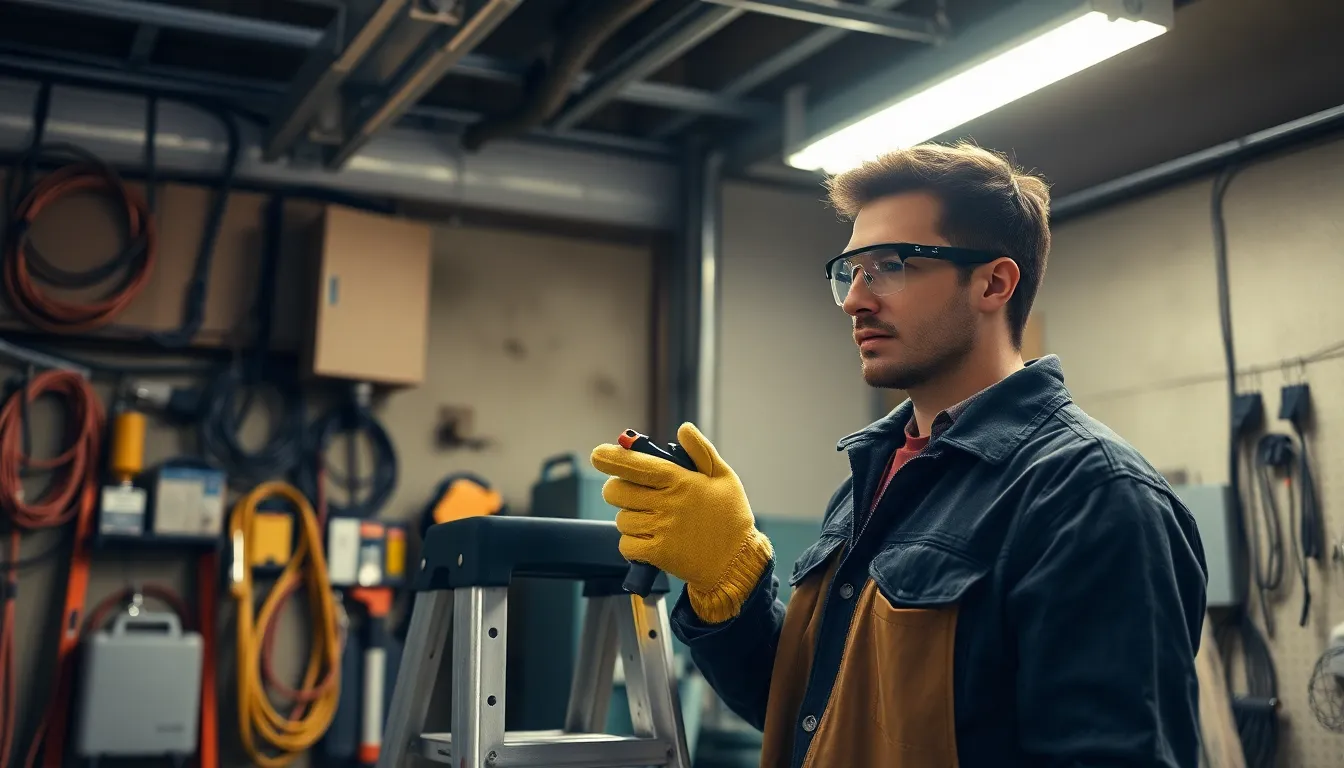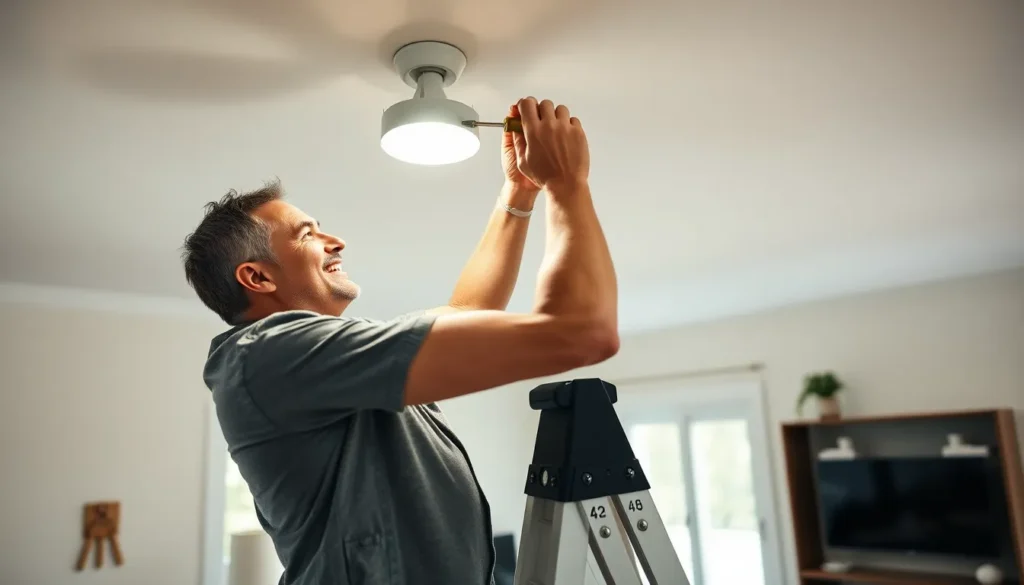Ready to spark your creativity? DIY electrical projects are the perfect way to light up your home and impress your friends—without burning a hole in your wallet. Whether it’s installing that trendy pendant light or wiring up a new outlet, these projects can transform a dull space into a dazzling showcase of your skills.
Table of Contents
ToggleOverview of DIY Electrical Projects
DIY electrical projects provide homeowners an opportunity to enhance their living spaces creatively. Many projects improve functionality and aesthetics, such as installing new light fixtures or creating outdoor lighting designs. Safety remains a top priority, especially when working with electricity. Using appropriate tools and taking proper precautions ensures successful outcomes.
Types of projects vary widely, from simple tasks like replacing switches to more complex installations, such as wiring a ceiling fan. Individuals often find installing dimmer switches or smart home systems rewarding. By gaining basic electrical knowledge, homeowners gain confidence in tackling various tasks independently.
Cost savings represent another advantage. Completing projects without hiring a professional can lead to significant reductions in expenses. Budgeting for materials and tools remains essential to maximize efficiency and effectiveness. Local hardware stores and online retailers offer a range of products suitable for DIY enthusiasts.
Learning opportunities abound within DIY electrical projects. Homeowners can acquire new skills by following tutorials or reading instructional guides. Engaging with dedicated forums helps individuals connect with others who share similar interests and challenges.
Ultimately, embracing the DIY approach fosters creativity and self-sufficiency. Accomplishing a project instills a sense of pride while enhancing one’s home environment. Taking these steps results in spaces that reflect personal style and ingenuity.
Safety Precautions

Safety remains paramount during DIY electrical projects. Understanding the risks and taking appropriate measures ensures a safe working environment.
Tools and Equipment Needed
Proper tools enhance safety and effectiveness. Use insulated screwdrivers and wire strippers for handling electrical components. Safety goggles protect eyes, while gloves provide hand safety. A voltage tester identifies live wires, minimizing shock risk. Additionally, a sturdy ladder supports safe access to elevated areas.
Common Mistakes to Avoid
Ignoring safety protocols leads to dangerous situations. Forgetting to turn off the power before beginning work poses significant risks. Overlooking local building codes can result in unsafe installations and potential fines. Mislabeling circuit breakers creates confusion and safety hazards. Failing to double-check wiring connections may result in electrical shorts or fires.
Simple DIY Electrical Projects
Engaging in simple DIY electrical projects can significantly enhance functionality and style in a home. These projects not only improve living spaces but also allow for personal expression through creativity.
Creating a Basic Switch
Installing a basic switch updates a room’s lighting. Start by turning off the power at the circuit breaker to ensure safety. Remove the old switch by detaching the wires carefully, noting their positions for reconnection. Connect the new switch by attaching the wires to the corresponding terminals. After securing everything, mount the switch back into the wall and restore power to test functionality. Ensuring a functional lighting switch can enhance convenience in daily activities.
Installing Wall Outlets
Installing wall outlets provides additional access to power sources. Turn off the power at the circuit breaker, similar to switch installation. Cut an appropriate hole in the wall at the desired height. Secure the electrical box in place, followed by connecting the wires to the outlet. Use wire connectors to fasten the connections, ensuring a tidy installation. Mount the outlet to the box, and cover it with a faceplate. Restore the power and test the outlet to confirm it works properly. Adding more outlets can accommodate charging devices and creating a more organized space.
Intermediate DIY Electrical Projects
Intermediate DIY electrical projects offer an opportunity to enhance both functionality and aesthetic appeal in homes. These projects often require more skills and tools than simple ones, but they can also lead to impressive results.
Setting Up Outdoor Lighting
Installing outdoor lighting transforms outdoor spaces. Brilliant pathways or cozy patios become functional and inviting. Start by selecting appropriate light fixtures based on the desired ambiance. After that, map out the layout and gather necessary materials, including weatherproof wiring, junction boxes, and fixtures. Additionally, ensure all wiring adheres to local codes and tastes. Following safety protocols is vital. Always turn off power before beginning. Once the fixtures are secured, connect the wiring, making sure to maintain proper polarity. Finally, test the system before finalizing the installation.
Wiring a Ceiling Fan
Wiring a ceiling fan enhances air circulation and adds style to any room. Begin with selecting a safe and suitable location for the fan. After identifying the spot, remove the existing light fixture if present. Use a ceiling fan-rated electrical box to support the weight of the fan. Additionally, gather necessary tools and materials such as a voltage tester, wire connectors, and ceramic screws. When wiring, connect black wires to the fan and power source, white wires for neutral, and green or bare wires for ground. It’s important to follow the manufacturer’s installation instructions for specific wiring configurations. Testing the fan before securing it ensures all connections are correct and functional.
Advanced DIY Electrical Projects
Advanced DIY electrical projects offer opportunities for innovation and efficiency. Homeowners can delve into home automation systems and solar panel installations.
Home Automation Systems
Home automation systems enhance convenience and security. Installing smart lighting allows users to control brightness and color remotely. Thermostats can adjust temperatures automatically, optimizing energy usage. Homeowners benefit from integrating security cameras and alarm systems, which provide peace of mind. Choosing compatible devices ensures seamless connectivity and functionality. Resources like forums and tutorials offer guidance for setup and troubleshooting. Understanding local regulations becomes crucial for compliance and safety.
Solar Panel Installation
Solar panel installation provides eco-friendly energy solutions. Selecting the right location maximizes sunlight exposure and efficiency. Homeowners must evaluate roof conditions and angles before installation. Planning includes calculating energy needs and determining the size of the system required. Properly securing panels necessitates following manufacturer guidelines for safety and performance. Connecting to the home’s electrical system demands careful adherence to local codes and best practices. Overall, engaging in solar projects fosters sustainability and reduces energy costs.
DIY electrical projects offer a rewarding way to enhance home functionality and style. By taking on these tasks, homeowners not only save money but also gain valuable skills that foster creativity and self-sufficiency.
With a focus on safety and proper techniques, individuals can confidently tackle everything from simple switch replacements to advanced home automation systems. Engaging with the DIY community through tutorials and forums can provide additional support and inspiration.
Ultimately, embracing DIY electrical projects transforms living spaces while instilling a sense of pride in personal achievements. Whether it’s improving aesthetics or increasing efficiency, these projects open the door to endless possibilities.

